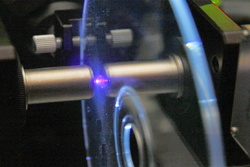Europe's online source of news, data & analysis for professionals involved in packaged media and new delivery technologies

Fresnel Institute's mirror trick could boost Blu-ray disc capacity
France's Fresnel Institute, in Marseille, has found a way of bringing images into sharper focus with the help of mirrors, with the potential of stacking more layers of data into Blu-ray discs.
Technically, an optical lens focuses a blue laser beam to a fine point on the disc, but in fact on the nanoscopic scale, the focal point is smeared out in the direction of light propagation – the beam's optical axis – to create a cigar-shaped cylinder, explains the Fresnel Institute. The research team is working towards improving that axial resolution that could allow lasers to focus more precisely within a Blu-ray disc, making it possible to squeeze more information layers onto each disc.
The New Scientist, that reports these developments, recalls that in the 1990s, a solution was found – the 4Pi microscope. Essentially, the system splits a laser light beam in two: one half is directed through a lens positioned over the disc scanned, while the other half passes through a lens under the disc and focuses on the images from below. The two beams interfere in just the right way to build on one another, creating a spherical focal spot that can be just 100 across.
The problem, as the Fresnel Institute team lead by Anne Sentenac explains, is aligning the two lenses and beam paths to interfere correctly, a difficulty that renders a 4Pi microscope expensive. The institute has found a simpler way to do it. The lens above the disc remains, but instead of splitting the laser beam and directing half of it through a lens below the object, a mirror is simply placed there. So, once the light has passed through the disc, some is reflected back towards the object from below, reducing the size of the focal spot, thus allowing for a sharper, more discriminating focal point.
Given that a Blu-ray disc is scanned with blue-violet laser with a wavelength of 405 nanometres, the “mirror” technique could make it possible to squeeze even more information on a layer and/or adding more layers on the disc. Recent developments by Pioneer has pushed the storage capacity to 500GB on a single disc by using 20 layers. By reducing the length of the beam spot, they could triple that number, according to Sentenac.
Some speculate the new technology could nearly double the number of layers in the 1-Terabyte Blu-ray disc shown off by TDK at the Ceatec Japan trade show last month, bringing 2-Terabyte discs within reach.
Story filed 20.11.10




















